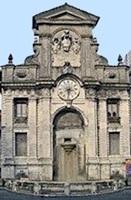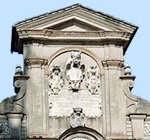
Stamp issued in 1956 to mark
400th anniversary of his birth
Carlo Maderno, who was born in the Swiss canton of Ticino, moved to Rome in 1588 to work with his uncle, Domenico Fontana. He had trained as a sculptor, but went on to become one of the leading architects of the Baroque period. His first major project was for the facade (1597–1603) of Santa Susanna, Rome. Pope Paul V then appointed him as the chief architect at St Peter’s, where he extended the nave and designed the facade. He continued as one of the leading architects in Rome until his death.
Perugia
Rebuilding of San Domenico (1625-32)

Spoleto
Barberini Monument (ca. 1623)


The Barberini monument was built in the upper part of the facade of San Donato before this structure was adapted for the Fonte di Piazza (1746-8). It was conceived in 1623, the year in which Cardinal Maffeo Barberini (who had been Bishop of Spoleto in the period 1608-17) was elected as Pope Urban VIII. His nephew, Cardinal Francesco Barberini visited the city in that year and agreed to become its protector. The Commune initially proposed to erect a statue of the new pope, but Francesco Barberini suggested this monument as an alternative.
The monument, which was inserted into the upper part of the surviving facade of San Donato, was designed in Rome by Carlo Maderno. The inscription records that the Senate and the people of Spoleto had experienced Barberini largesse in the fields of both civic and ecclesiastical government. The monument bears the arms of:
-
✴Urban VIII;
-
✴Cardinal Francesco Barberini; and
-
✴Cardinal Antonio Barberini.
Terni
Drainage of the Rieti Plain (1598)
Pope Clement VIII sent Carlo Maderno and Giovanni Fontana to improve the drainage of the Rieti plain. This was one of a number of unsuccessful attempts: success was achieved only in 1787 with the creation of the Cascata della Marmore.



